|
|

|
 |
|
 Space
Suits Space
Suits
There were several iconic items of equipment in the Dan Dare strip but
two that come to the fore are his primary space ship - the Anastasia (introduced
after the first Venus campaign). The other is undoubtedly his space suit.
This changed on a number of occasions but always seemed to return to
one main type: the Mark 3. Below is the description of this suit, plus
the sapce suit variations over the years.
This is a selection of those illustrations. Please click on the item to
enlarge and STRETCH them to the required viewing size.
Some of them are quite large so - if you have a slow internet link - please
be patient!
|
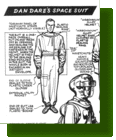 |
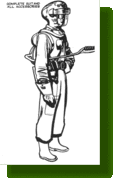 |
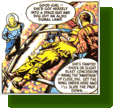 |
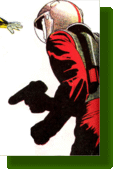 |
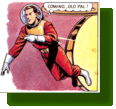 |
|
The Mk III Space Suit
|
The Mk III Space Suit
|
Light Suit
|
Suit in "Menace from Jupiter"
|
Lighter Suit
|
 |
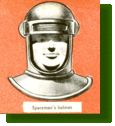 |
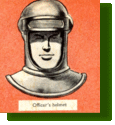 |
 |
 |
|
Late Suit
|
Digby's Uniforms
|
Dan's Uniforms
|
Sub Aqua suit
|
Suit in "Robocrabs"
|
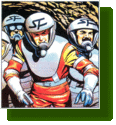 |
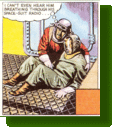 |
 |
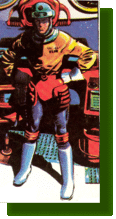 |
 |
|
Suit in "Project Nimbus"
|
Dare in a Theron suit
|
McHoo Suits
|
Suit in "Operation Saturn"
|
The Mk III suit in action
|
SPACE FLEET STANDARD SPACE SUIT (MARK 3 - l999)
The helmet is the nerve centre of the whole suit and is constructed of Hirschinium,
a metal alloy of extremely light weight and almost incredible strength, perfected
by Erwin Hirshbaum in 1980. One of its most valuable features is that it does
not conduct heat at all. In the rear of the helmet in the overhang incorporated
to carry them are the tiny electronic automatic control devices to keep the
wearer comfortable inside the suit despite the conditions outside.
A thermostatic control keeps the temperature constant through a network of
heating wires (9) and cooling channels embedded in the fabric of the suit. A
microscopic diaphragrn valve in the outer surface on the top of the helmet connects
with an outlet valve in the air tanks built in the crown of the helmet in these
tanks a breathable combination of gases is stored in liquid form at an incredibly
low temperature which is insulated from the rest of the suit by the non-conducting
Hirschinium. This liquid breathing mixture is released into the suit through
the outlet valve, which warms and expands it through the Thermovent device invented
in 1985 by Lewell Hudson, which overcame the difficulty of returning gases which
had been liquefied to their original form. The Diaphragm control releases this
gas in sufficient quantities to equalise the pressure of any 'reasonable' atmosphere
outside. In space the diaphragm is naturally at Minimum Pressure which does
not cut off the supply of breathing mixture but releases just enough for breathing.
Spring-loaded throat microphones press against the wearer's throat and transmit
his speech on short range radio on a predetermined wave length which allows
it to be received by other suit wearers in the vicinity through the built-in
earphones. Long range radio transmission can be used by plugging a 'Walkie Talkie'
set into the 2-pin plug on the helmet
As an auxiliary air supply, some helmets are fitted with air intake holes in
the bottom of the rear overhang which allow outside atmosphere to enter the
helmet through filter pads. The point of this is that for planetary exploration
in atmospheres that might contain some usable gases and some in poisonous quantities
the filters clean such air in much the same way as a poison gas respirator and
allow it through the breathable combination only. In this case a knob is situated
on the right hand side of the helmet which the wearer adjusts to cut of the
interior supply and adjust the right filters to the intake. Dan and Digby used
this type on Venus when they first landed. The external storage pocket of the
suit is normally for convenience in carrying tools etc., but for exploration
duties it carries a Hyposyringe kit and water making outfit. It is possible
to keep alive for a considerable period, in emergency, within the suit, by taking
food in the form of injections by the hypodermic syringe. The injections are
mode direct into the arm trough the self-sealing fabric of the suit.

 Space
Suits
Space
Suits













